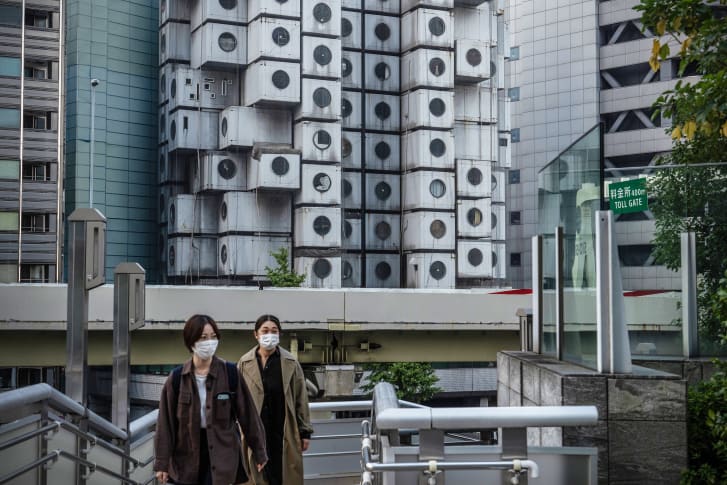The building is considered a prime example of Metabolism, an architectural movement that emerged from the ruins of World War II with a radical new vision for Japan's cities. As well as embracing technology and mass production, the avant-garde group's members looked to nature for inspiration, with structural components treated like organic cells that could be "plugged" into a larger whole or later replaced.
The Japanese architects who treated buildings like living organisms
TTe building's designer, Kisho Kurokawa -- one of Metabolism's youngest adherents -- had originally envisaged the Tokyo tower's capsules being replaced every 25 years. But they instead grew dilapidated and outdated, with many of the apartments now sitting empty, used for storage and office space, or rented out to architecture enthusiasts on a short-term basis.
In 2007, the owners' association voted to sell the tower to a property developer that intended to demolish and replace it. But the firm filed for bankruptcy during the 2008 recession, and the site's fate was thrown into years-long limbo.
Preservationists hope some of the the 108-square-foot capsules can be saved and repurposed or acquired by museums. Credit: Carl Court/Getty Images
Owners again agreed to sell in 2021, and the building was acquired by a group of real estate firms operating under the name Capusule Tower Building (CTB). A spokesperson for the joint venture, Takashi Shindo, told CNN over the phone that the last residents moved out last month, with demolition scheduled to begin April 12.
Preservationists had long expressed hope that the building might be saved -- including Kurokawa, before his death in 2007. Petitions and campaigns have called for the structure to be protected as an example of Japan's architectural heritage. (Although the Metabolism movement proved influential, very few of its proposals were ever realized, making Nakagin Capsule Tower a rare living example of the group's philosophy.)
The organization behind the conservation campaign, the Nakagin Capsule Tower Building Preservation and Regeneration Project, asked city authorities to intervene -- and even considered applying for protected status with UNESCO. But neither approach proved successful, according to project member Tatsuyuki Maeda, who acquired 15 of the capsules between 2010 and the building's sale last year.
"Japan does not have the legislation to preserve this kind of architectural culture," he said over the phone. "It is unfortunate that one of the country's most representative examples of modern architectural heritage will be lost."Maeda said that efforts to raise the 2 to 3 billion yen ($16 million to $24 million) required to renovate the tower and remove asbestos were hampered by the Covid-19 pandemic. The project has since shifted focus towards raising funds to refurbish and repurpose individual units in the hope that institutions might look to acquire "unplugged" capsules.
Maeda said the project has received around 80 inquiries, with the Centre Pompidou in Paris among the museums to have expressed interest in obtaining one, he added. The Museum of Modern Art in Saitama, Japan, meanwhile has a unit in its collection already.
Kurokawa's architecture firm, which continued operating after his death, announced that it intends to preserve the building in a "digital space
.""We are determined to preserve the capsules, even if the building is demolished," said Maeda. "Dozens of capsules with relatively little aging will be recovered and rehabilitated.
"There is no doubt that the building was famous, but the Capsule Tower also had a certain charm that appealed to people. Everyone who stayed there was creative in his or her own way, and the community that formed was truly fascinating. I am sad to see it go, but I hope it will live on in a new form."


%2004.png_j.jpg)







.jpg)
.jpg)
Gumercrafts Social Media